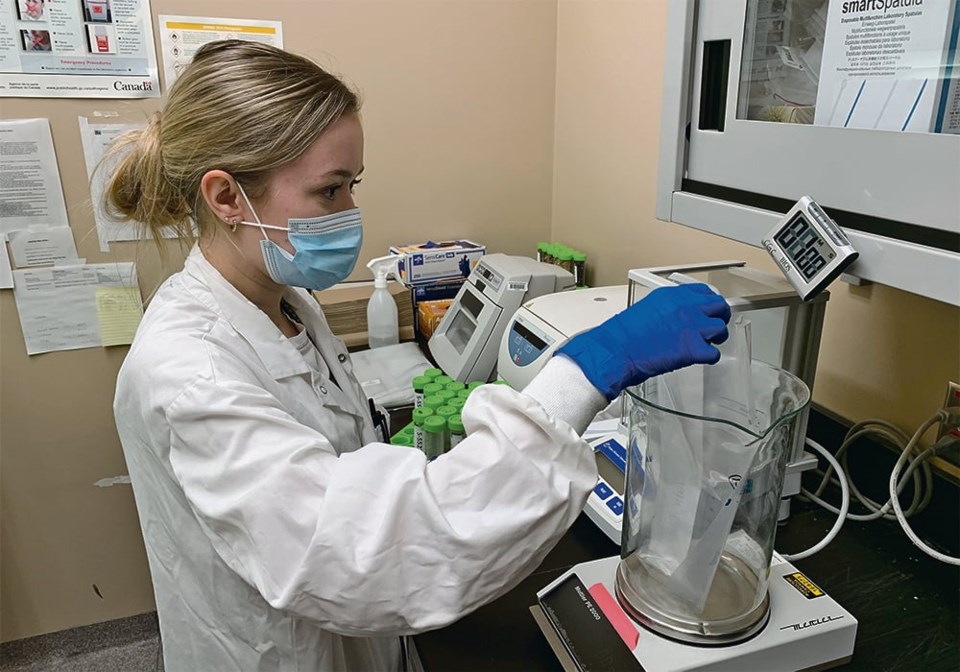Farmers fighting fusarium use every weapon they have to fend off the feared fungus.
Grain graders peer closely at farmer and elevator sample kernels to catch the quality-damaging and health-challenging cereal grain infection.
But both sectors struggle with the problem. They see the symptoms and signs but have to guess what’s really going on deep within the crop and the grain.
In the Canadian Grain Commission’s laboratories, the rapid evolution of technology is allowing scientists to spot, catch and exactly identify specific strains of diseases like fusarium, the toxins they produce and many other threats to grain quality and safety.
“If there’s an issue that’s affecting producers, we want to be able to address it immediately,” said Sean Walkowiak, the senior commission research scientist who oversees the CGC’s microbiology and grain genomics laboratories in Winnipeg.
“We can get the sample, isolate the DNA and test it right away.”
Rapid and accurate DNA analysis is giving CGC staff abilities they could only dream of just a few years ago. It provides a way to eliminate threats to Canadian grain’s reputation for high quality.
Problems in farmers’ fields can be quickly flagged and producers provided with management options for a number of disease and pest problems that might be hard to assess with eyeballs only.
Exporters and millers can get quick answers to questions about quality and importers can find out if problems they think they’re seeing are serious or benign.
CGC staff use various testing technologies, including rapid DNA sequencing, to maintain and develop the standards that Canada claims its crops embody, and to meet importers’ demands.
“We (have) conversations with them so that we know what the community (of crop users) needs and help establish the standards accordingly, keeping them in line with what we think is appropriate for safety and quality, and so we can maintain the Canadian brand and make sure producers are competitive,” said Walkowiak, as he led a reporter on a tour of his lab.
The CGC’s main labs are in the research park attached to the University of Manitoba. This location gives it access to talent in the form of facilities, professors, scientists and students.
Within the secure warren of labs, machines hum, buzz and breathe. The white noise of controlled air systems reveals the high biosecurity measures necessary for handling microbes, toxins, pests and infectious agents that pose a threat to crops, animals and humans. They can’t be allowed to escape.
Some rooms must be entered through what is effectively an air-lock system, with negative air pressure sucking in the air and preventing it from leaking into the outside. That air is then filtered and purified.
“We need to be able to work with various pathogens and make tests for them, but we can’t just do that in our garage. We need to ensure if we’re working with these things that we’re not releasing anything that poses a risk,” said Walkowiak.
Inside one freezer sits a collected history of Canadian crop diseases, with samples of crop blights going back decades. Inside the -150 C crop crypt sit examples of what previous infections look like on grain and also the organisms themselves.
“We can actually take them out and grow them,” said Walkowiak about the samples in the Culture Collection. “They’re still alive.”
Hence the high security.
Having historical samples has benefits for today because modern technology can break apart old infections’ DNA the way previous testing never could. Previous generations of scientists often had to grow out diseases, infect crops, see the results and then make an educated guess about the diseases’ identities. A detailed analysis of specific disease species, strains, races and varieties was often impossible.
“It was really laborious and costly,” said Walkowiak.
Just down the hall from the room with the Culture Collection, laboratory technician Maria Eckhardt is working near the start of new processes that allow the diseases to be exposed in all their details.
She’s mixing small samples of grain with nutrient liquids to create a grainy soup that will pull microbes and other substances out of the seeds so their DNA can be extracted.
It’s important to know what pathogens, life forms and substances are on a crop because some are harmless and some definitely harmful. The common bacillus thuringensis, which is used as a natural control for various insects in crops, is related to anthrax, a dreaded disease for mammals including humans.
“They’re quite diverse,” said Walkowiak about pathogen families.
Various high-tech tools can be used to crack the codes of crop diseases and toxins. Walkowiak, the lab’s workers and university researchers are able to use an array of expensive and cutting-edge equipment that isn’t usually available for crop assessment, such as rapid DNA sequencers and a mass spectrometer.
The lab houses a number of different DNA sequencers, each with its particular strengths and weaknesses. By combining the technologies, researchers can get a highly refined picture of what’s going on within the microscopic critters they’ve found.
“There aren’t many labs that have that,” said Walkowiak.
The machines don’t look impressive. Some look much like kitchen appliances. But the miniaturization they employ is stunning.
On one tiny two-inch panel, there is room for 5,200 samples. Throughout the lab, tiny technologies combine to provide a picture of complexity unimagined just a few decades ago.
It’s all based on the dusty, dirty, grainy reality of the crops growing in farmers’ fields, as attested by the boxes of sample bags from the CGC’s annual crop survey. Thousands of farmers send in samples, and technicians and scientists in these labs spend their working days breaking them apart to see what farmers are dealing with and how that’s affecting the crops Canada is selling.
These buzzing, humming rooms housing sophisticated machines and white-coated scientists might seem a long way from the fields, but through their work, they’re closer to the grain and its realities than anybody but the farmer.



